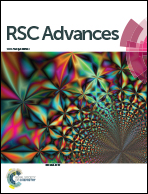Fractality and metastability of a complex amide cross-linked dipodal alkyl/siloxane hybrid†
Abstract
A novel room-temperature white light emitter amide-cross linked alkyl/siloxane hybrid material (amidosil A) was produced by self-organization through the rational design of the precursor. This hybrid displays a highly complex hierarchical architecture composed of two lamellar bilayer structures, the relative spatial arrangement of which yields a multiplicity of ordered nanodomains with variable shapes and sizes, some of them persisting at the microscale. Macroscopically A was obtained as clusters of hydrophobic hemispherical and spherical micro-objects exhibiting a lettuce coral-like pattern, which represent unprecedented pieces of evidence illustrating the principles of self-similarity and demonstrating that the time scale of biomimetic morphogenesis in this non-bridged silsesquioxane is similar to that in biological systems. Heating metastable A above the order/disorder phase transition acted as an external quake driving the material to another metastable state, which has persisted for more than 12 months, and was manifested as a marked change of all the macroscopic properties. The occurrence of the self-organization process operating on A, instead of a self-directed assembly, is primarily associated with the formation/rupture of hydrogen bonds, therefore supporting that these interactions are critical factors dictating on what side of the self-assembly/self-organization boundary a non-bridged silsesquioxane system will evolve.


 Please wait while we load your content...
Please wait while we load your content...